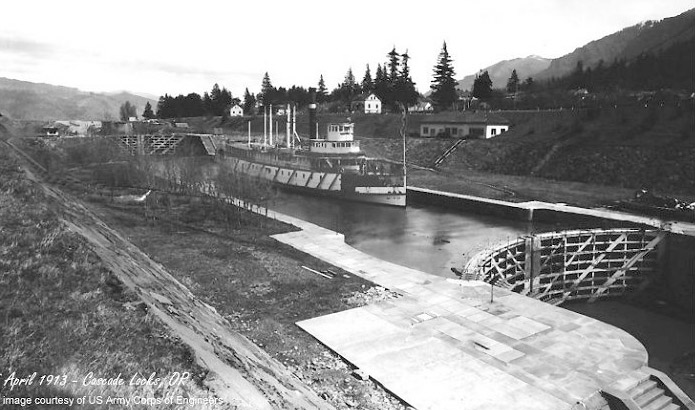History
History of Cascade Locks
The history of Cascade Locks is intimately tied to the Columbia River. The small settlement that grew up on the banks of the river helped early travelers portage around the rapids, first by foot, then by mule-drawn rail cars, steam engines, and finally riverboats.
Lewis and Clark’s Corps of Discovery portaged around the rapids of the Cascades in 1805. They wrote in their journal, “this great chute of falls is about 1/2 a mile with the water of this great river compressed within the space of 150 paces…great number of both large and small rocks, water passing with great velocity forming & boiling in a horrible manner, with a fall of about 20 feet” (October 30- November 1, 1805).

Forty years later pioneers traveling the Oregon Trail’s water route were forced to make the same portage around the dangerous rapids. Travelers heading west had to make a crucial decision just upstream of these rapids at The Dalles, Oregon. They had to choose whether they would risk life and limb on Mt. Hood’s steep Barlow Road, and overland toll route, or build a raft and float down the Columbia River, risking their life free of charge.

The little Oregon Pony, the first steam engine west of the Mississippi River, carried passengers and freight past the rapids in 1864. Today, the engine can be viewed in Marine Park.
In 1896, the navigational canal and locks at the site of the rapids were completed, and modern-day Cascade Locks was born.

The locks allowed safer navigation of the river, and riverboat whistles echoed in the Gorge each day as the boats made their runs from Portland and The Dalles. Passengers still disembarked at Cascade Locks for portage around the rapids until 1938, when Bonneville Dam succeeded in completely taming the rapids.
Eventually, passengers and freight were drawn to more modern forms of transportation, and roads and railroads displaced the sternwheelers. Although the romantic days of the sternwheelers are now past, you can experience a taste of history aboard the Sternwheeler “Columbia Gorge,” an authentic replica of a triple-decker paddle wheeler in size and construction.
History of the Port: A Legacy of Navigation and Growth
Established in 1937, the Port of Cascade Locks played a pivotal role in the Columbia River's navigation history. Initially formed to as a jurisdiction to accomplish Columbia River navigation channel improvements, the Port took ownership of the obsolete Cascade Locks from the U.S. Army Corps of Engineers in 1939, following the construction of Bonneville Dam. Since then, the Port has continuously evolved, launching numerous initiatives and facilities to drive economic development in the region.
The Port district encompasses the charming City of Cascade Locks, nestled along the Columbia River Gorge National Scenic Area, just 45 miles east of Portland and 20 miles west of Hood River. With a population of around 1,500, Cascade Locks offers a vibrant community atmosphere. The unincorporated areas within the district have minimal impact on the overall population size.
Today, the Port of Cascade Locks remains dedicated to fostering economic growth and prosperity in the region. Their commitment to innovation and collaboration ensures a bright future for Cascade Locks and the surrounding communities.
